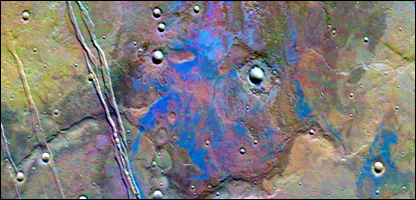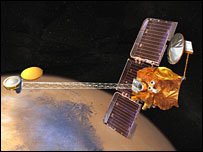Mars is 'covered in table salt' 

False-colour, composite image showing possible chloride salts (in blue)
Mars appears to be covered in salt crystals from ancient dried-up lakes, new evidence suggests. A Nasa probe has found signs that the southern hemisphere is dusted with chloride mineral, perhaps "table salt".
US scientists think the mineral formed when water evaporated from salty lakes or soil billions of years ago. The deposits, similar to salt-pans on Earth, are a good place to search for traces of past life preserved in salt, they report in the journal Science.
The evidence comes from a camera on Mars Odyssey, which has been mapping the Red Planet since early 2002. The camera images Mars in the visible and infrared parts of the spectrum in order to work out the distribution of minerals on the surface.
| Salt is an excellent means of preserving organic material, so if there was life present in the distant past, the signature might still be there Dr Philip Christensen |
It found about 200 places with spectral "fingerprints" consistent with chloride salt deposits. All were in the middle to low latitudes of the ancient, heavily cratered terrain in the southern highlands.
Team member Professor Philip Christensen, of the School of Earth and Planetary Exploration at Arizona State University, Tempe, said the most likely chloride mineral "would be good old table salt (sodium chloride)".
He said many of the deposits lay in basins with channels leading into them, the kind of feature that is consistent with water flowing in over a long time.
He told BBC News: "Two possible mechanisms would be the evaporation of a large body of water (like a salt lake on Earth), or capillary action in the soil that could draw salt-rich water toward the surface, where the water evaporates and the salt is left behind and accumulates. "Either case is exciting because it implies a large amount of water near the surface."
Warmer, wetter
The team - which also includes members from the University of Hawaii, University of Arizona and Stony Brook University - thinks the deposits formed about four billion years ago, when Mars was probably much warmer and wetter.
The locations range in area from one square kilometre to about 25 square kilometres, which approaches the size of some of the largest lakes on Earth.
The discovery suggests that there was once a lot of water near the surface of Mars and a source of energy, namely sunlight, said Dr Christensen. He added: "Salt is also an excellent means of preserving organic material, so if there was life present in the distant past, the signature might still be there."
The scientists say the areas with chloride minerals should be given a high priority for future rover missions to Mars. Until now, efforts have largely concentrated on a handful of places that show evidence of clay or sulphate minerals.
Andrew Knoll of Harvard University's Department of Earth and Planetary Sciences, who was not part of the study, said it suggested that water once occurred widely on the Martian surface, as salty transient deposits - playa lakes, not oceans. Mars appears to be covered in salt crystals from ancient dried-up lakes, new evidence suggests. A Nasa probe has found signs that the southern hemisphere is dusted with chloride mineral, perhaps "table salt".
Mars Odyssey: Its data suggests water was once plentiful
But he said the findings carried "a double-edge sword for astrobiology". "Water is the first sign that an environment might have been habitable, but waters that precipitate table salt on Mars would have been much saltier than any waters known to support microbial populations on Earth," he explained.
Story from BBC NEWS |  |
Source: By Helen Briggs. Science reporter, BBC News
http://news.bbc.co.uk/go/pr/fr/-/1/hi/sci/tech/7302591.stmScience news
|